The 10 Best Belly-Fat Melting Tips for Beginners

If you care about your overall health and wellness, you’re most likely well aware of the risks and annoyances linked to excess belly fat. It’s so easy to put on—especially as you age. But getting rid of it is an entirely frustrating process. That’s why we spoke with trainers who share their best belly fat melting tips for beginners, because getting started can be one of the most challenging parts of the process.
Should you be concerned if you have excess belly fat? Well, if you’re female and your lower belly region measures over 35 inches (or over 40 inches if you’re a male), listen very carefully. According to The National Heart, Lung, and Blood Institute, you have a heightened risk of developing chronic conditions such as type 2 diabetes or heart disease if you have a high BMI. We know it’s concerning, which is why Eat This, Not That! spoke with the experts and learned some very useful information for you. So before you put that tape measure away, read on to learn the best belly fat melting tips for beginners, according to trainers. When you’re done, check out the 10 Best Exercises To Melt Lower Belly Fat.
Get plenty of cardio.

Cardio is truly the real MVP. It helps get your body moving and boost your metabolism. According to Sasha Mihovilovic, NASM-CPT and master trainer for AKT, “Cardio can be simply defined as aerobic exercise that increases your heart rate. When it comes to fat loss, jumpstarting your metabolism is a necessary component, the goal is to boost your resting metabolic rate. By doing cardio more regularly, you will burn more energy at rest post-workout (in addition to the calories burned in the actual workout), which can help you maintain a healthy weight over time and decrease body fat.”
When it comes to cardio, you have so many options to choose from, including running, bike riding, HIIT, dancing, walking, and even rollerblading.
Maintain an anti-inflammatory diet.
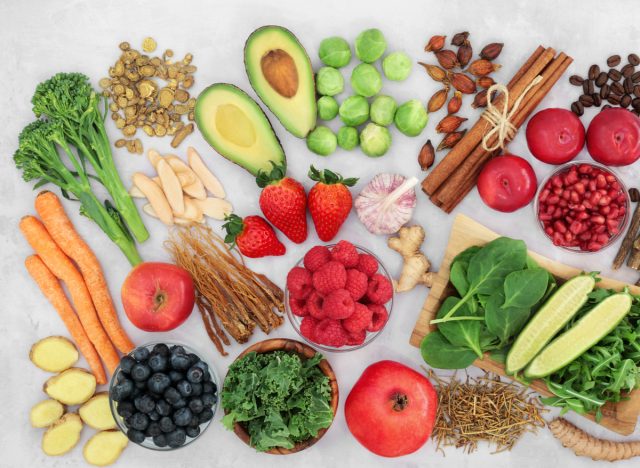
Of course, it’s important to check in with your physician prior to making any dietary changes. There’s plenty of misinformation when it comes to diets, and it can be challenging to sift through what’s right and what isn’t for you.
Mihovilovic suggests, “What I always recommend for anyone is to start with a diet that is focused on whole foods that are anti-inflammatory and minimizing processed foods/beverages. Eating a diet that is anti-inflammatory can promote a healthy gut microbiome and slow down digestion to prevent spikes in blood glucose.”
Stay hydrated.
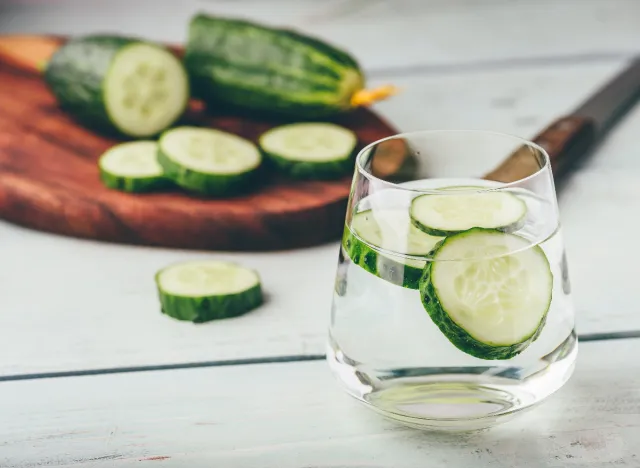
Drink up, because water is so important to feed your daily needs. In fact, according to the Mayo Clinic, the primary chemical component of the human body is approximately 50% to 70% of H2O. “Drinking more water may also help with feeling fuller for longer, reduce hunger, and help the body remove waste more efficiently,” Mihovilovic tells us.
Keep a consistent routine.

It’s okay to start off easy, but it’s extremely important to be consistent with your efforts. Mihovilovic advises, “Whether you are starting off with working out, adjusting your diet, or dialing in more on your current programming, start with smaller, simpler, more attainable goals. Even if it’s just for one week, your focus is on hydrating better, that’s going to feel more attainable than changing everything all at once. In the long term, you’ll get the results you’re looking for and your lifestyle will be more sustainable!”
For instance, if you’ve taken a long break from working out and go right into a five-to-six-day workout routine, you may totally “crash and burn,” Mihovilovic warns. She recommends kicking off with two to three half-hour workouts each week. In addition, plan more walks during your day. Do this for a month and work on being consistent and forming new habits. This will set you up strong for your next month.
Incorporate strength training into your regimen.
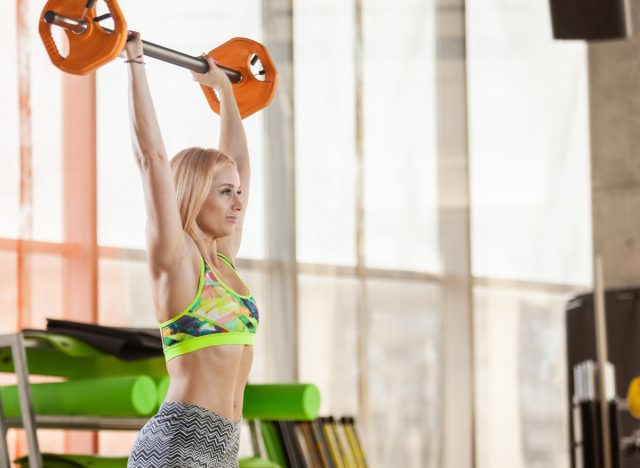
Strength training is essential, as it builds muscle mass, which in turn increases your resting metabolic rate. This leads to a greater number of calories burned, even when you’re not working out.
Alissa Tucker, NASM-CPT and master trainer for AKT, tells us, “Weightlifting promotes the afterburn effect, where the body continues burning calories post-exercise. This process aids in overall fat reduction, including visceral fat around the midsection. For optimal benefits, I recommend adding strength training into your routine three times per week. Choose a weight size that allows you to maintain proper form but feels challenging, especially for the last few reps.”
Get quality sleep.

Getting good quality sleep—and enough of it—is essential when it comes to lowering belly fat. “Sleep deprivation can disrupt hormonal balance, leading to an increase in hunger hormones and a decrease in satiety hormones,” Tucker explains. “This imbalance can result in overeating and choosing sugary or high-calorie, low-nutrient foods. Inadequate sleep also affects insulin sensitivity, making the body more prone to storing fat, particularly around the abdomen.”
The Sleep Foundation recommends getting seven or more hours of restful sleep on a nightly basis. In addition, you can boost your chances of better sleep by heading to bed at the same time each night, powering down blue light devices before sleep, and avoiding caffeinated beverages late in the day.
Sync your workouts to your cycle.
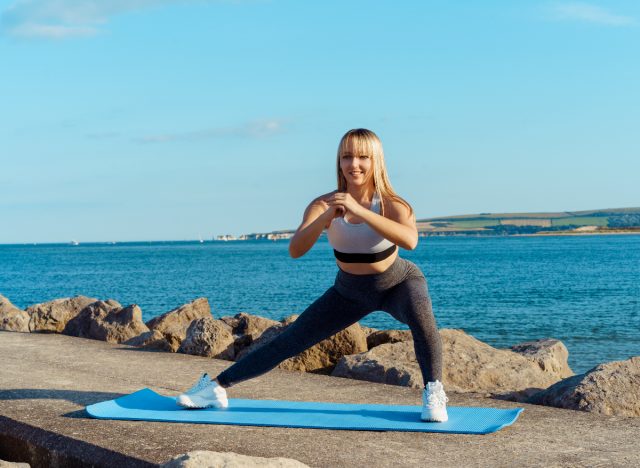
Did you know that syncing your workouts or exercise intensity to your menstrual cycle can help maximize your metabolism and hormonal balance? This could lead to a decrease in belly fat in time, Tucker explains.
“Simply put, it is recommended to keep your high-intensity and cardio workouts in the first half of the cycle (follicular and ovulatory phase) and stick to strength-based workouts during the second half (luteal and menstrual phase),” Tucker adds.
“Sneak” exercise into your routine.

Another subtle yet effective belly fat-melting tip from Tucker? Sneak little forms of physical activity into your day.
“Taking the stairs instead of the elevator, parking further away, or even walking/biking to work, if possible, can play a significant role in reducing belly fat over time,” Tucker explains. “These small lifestyle changes increase daily calorie expenditure, helping to support weight management. While these actions might seem minor individually, their cumulative effect can have significant effects on weight loss and overall health.”
Eat soluble fiber.
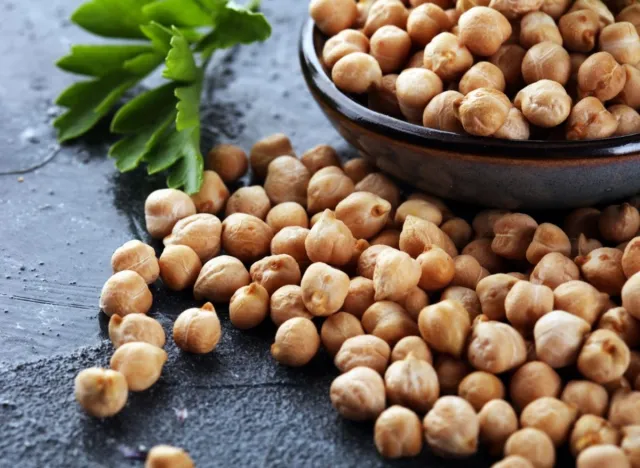
A nutritious diet is another crucial piece of the belly fat loss puzzle. Tucker encourages you to add more high-fiber foods to your diet, like chickpeas, carrots, sweet potatoes, lentils, bananas, berries, and avocados.
“Soluble fiber helps you feel full which can help prevent overeating and food cravings,” Tucker explains. “One study found that increasing daily soluble fiber intake by 10 grams, led to a 3.7% lower risk of gaining belly fat.”
Manage your stress.

Last but not least, Rebecca Butkivich, instructor for AKT, encourages you to get a handle on excess stress. “When you work out, your cortisol levels rise, which in turn levels them out throughout the day,” Burkivich explains. “If you are stressed, it keeps your cortisol levels high throughout the day, not giving your body a chance to drop. This [affects] your overall gut health. By concentrating on managing stress, you will reduce visceral belly fat.”
Managing your stress levels is crucial to be mindful of on a daily basis. A solid place to start is by adding meditation to your routine. “Starting and ending your day with guided meditation can help start your day in a positive headspace and before bed for a restful night,” Butkivich adds.
- Source: Why belly fat is dangerous and how to control it
- Source: Assessing Your Weight and Health Risk
- Source: Water: How much should you drink every day?
- Source: Effects of acute sleep loss on leptin, ghrelin, and adiponectin in adults with healthy weight and obesity: A laboratory study
- Source: How Much Sleep Do You Need?
- Source: A weight-loss program adapted to the menstrual cycle increases weight loss in healthy, overweight, premenopausal women: a 6-mo randomized controlled trial
- Source: Lifestyle factors and 5-year abdominal fat accumulation in a minority cohort: the IRAS Family Study
- Source: Stress and abdominal Fat: Preliminary Evidence of Moderation by the Cortisol awakening Response in Hispanic Peripubertal Girls









